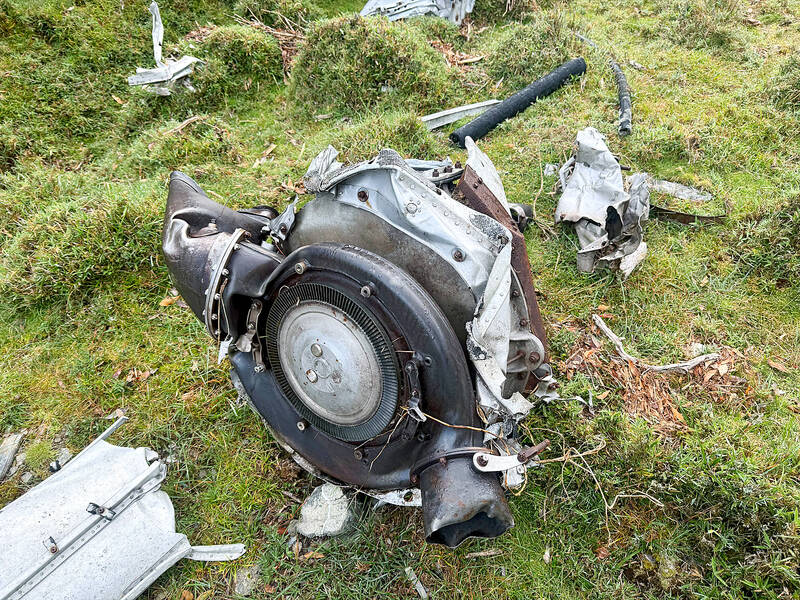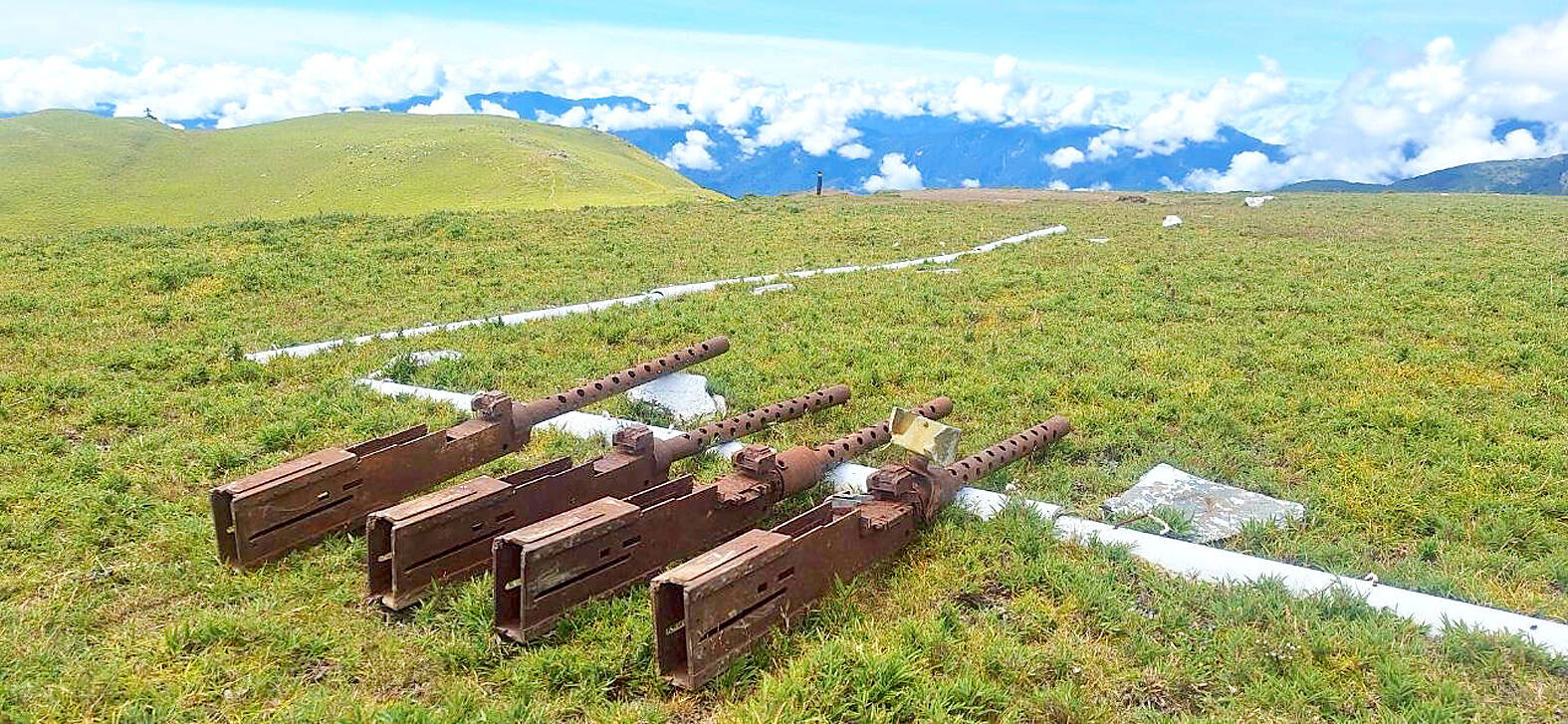Taiwan yesterday marked the 80th anniversary of the Sancha Mountain Incident, when a US B-24 bomber carrying freed Allied prisoners of war crashed in the Central Mountain Range, leading to the deaths of all 25 onboard and 26 who were caught in a storm trying to rescue them.
The crash occurred on Sept. 10, 1945, one month after Japan’s surrender in World War II.
Eleven American, four Dutch and five Australian prisoners of war were killed, as well as five American crew members.

Photo: CNA
More than a dozen Indigenous Taiwanese people and nine Japanese military and civil policemen, who were serving in Taiwan during Japan’s colonial rule of the island, perished in the subsequent rescue attempt due to bad weather.
Only one Taiwanese newspaper, the Taiwan Shinpo (台灣新報), reported the crash on Sancha Mountain — a peak in the southern Central Mountain Range rising 3,496 meters -- at the time of the incident, devoting fewer than 300 words to it on Oct. 24, 1945.
“Eighty years later, we have not forgotten,” said President William Lai (賴清德) in a Facebook post yesterday.

Photo courtesy of a private contributor via CNA
“As we reflect on the shared lesson of World War II -- that unity prevails, aggression is inevitably defeated -- 80 years ago, a group of people, without regard to nationality, blood, or side in the war, risked their lives to save others.”
Taiwan’s Ministry of National Defense (MND) said that military personnel recently went to the crash site, where wreckage including wheels, engines, canteens, fuselage pieces and five machine guns remained scattered in the area.
Four of the machine guns were first carried to Jiaming Lake, an alpine lake in the Central Mountain Range in Taitung County, and then transported away by helicopter on Monday, the ministry said.
The weapons will be displayed at the National Military Museum in Taipei once construction there have been completed, the MND added.
The crash and rescue disaster went largely unrecognized for decades.
Memory of the incident resurfaced in 1998 when historian Shih Tien-fu (施添福) documented it during research fieldwork for a town chronicle commissioned by the Guanshan Township (關山) Office in Taitung County, southeastern Taiwan.
In 2001, a memorial was erected in the township. Recollecting the incident, Ku Amu (古阿木), 96, of Chulai (Sulaiyaz) Tribal Village in neighboring Haiduan Township, said in June that the victims were first buried at the site, and that a year later, people from Lidao (Litu) Tribal Village were asked to help recover bones.
Residents of the village, however, said they had no recollection of their folk undertaking such a task.
Hsu A-yung (余阿勇), the son of the hunter who discovered the wreck, recalled that his father and grandfather heard an explosion while hunting and found “everyone dead” in the torn-apart fuselage.
He said hunters removed clothing from the victims and wore it back in the village because clothing was scarce at the time.
Hsu said Japanese police officers mistook the clothing as evidence that Americans were in the village and were too afraid to enter until they learned of the crash.
He added that some villagers later tried to carry wreckage down to sell, but he had no memory of bones being moved.
Taiwan’s Veterans Affairs Council confirmed that 16 US servicemen were reburied on Feb. 22, 1950, at Jefferson Barracks National Cemetery in St. Louis, Missouri, adding that the burials contained actual remains and not just symbolic interments.
In June this year, a government mission team was sent to Sancha Mountain to hold a memorial ceremony, President Lai said on Facebook.
The team also surveyed the crash site, and in early September carried wreckage down for systematic preservation and record-keeping, he said.

US climber Alex Honnold is to attempt to scale Taipei 101 without a rope and harness in a live Netflix special on Jan. 24, the streaming platform announced on Wednesday. Accounting for the time difference, the two-hour broadcast of Honnold’s climb, called Skyscraper Live, is to air on Jan. 23 in the US, Netflix said in a statement. Honnold, 40, was the first person ever to free solo climb the 900m El Capitan rock formation in Yosemite National Park — a feat that was recorded and later made into the 2018 documentary film Free Solo. Netflix previewed Skyscraper Live in October, after videos

Starting on Jan. 1, YouBike riders must have insurance to use the service, and a six-month trial of NT$5 coupons under certain conditions would be implemented to balance bike shortages, a joint statement from transportation departments across Taipei, New Taipei City and Taoyuan announced yesterday. The rental bike system operator said that coupons would be offered to riders to rent bikes from full stations, for riders who take out an electric-assisted bike from a full station, and for riders who return a bike to an empty station. All riders with YouBike accounts are automatically eligible for the program, and each membership account

NUMBERS IMBALANCE: More than 4 million Taiwanese have visited China this year, while only about half a million Chinese have visited here Beijing has yet to respond to Taiwan’s requests for negotiation over matters related to the recovery of cross-strait tourism, the Tourism Administration said yesterday. Taiwan’s tourism authority issued the statement after Chinese-language daily the China Times reported yesterday that the government’s policy of banning group tours to China does not stop Taiwanese from visiting the country. As of October, more than 4.2 million had traveled to China this year, exceeding last year. Beijing estimated the number of Taiwanese tourists in China could reach 4.5 million this year. By contrast, only 500,000 Chinese tourists are expected in Taiwan, the report said. The report

Temperatures are forecast to drop steadily as a continental cold air mass moves across Taiwan, with some areas also likely to see heavy rainfall, the Central Weather Administration (CWA) said. From today through early tomorrow, a cold air mass would keep temperatures low across central and northern Taiwan, and the eastern half of Taiwan proper, with isolated brief showers forecast along Keelung’s north coast, Taipei and New Taipei City’s mountainous areas and eastern Taiwan, it said. Lows of 11°C to 15°C are forecast in central and northern Taiwan, Yilan County, and the outlying Kinmen and Lienchiang (Matsu) counties, and 14°C to 17°C